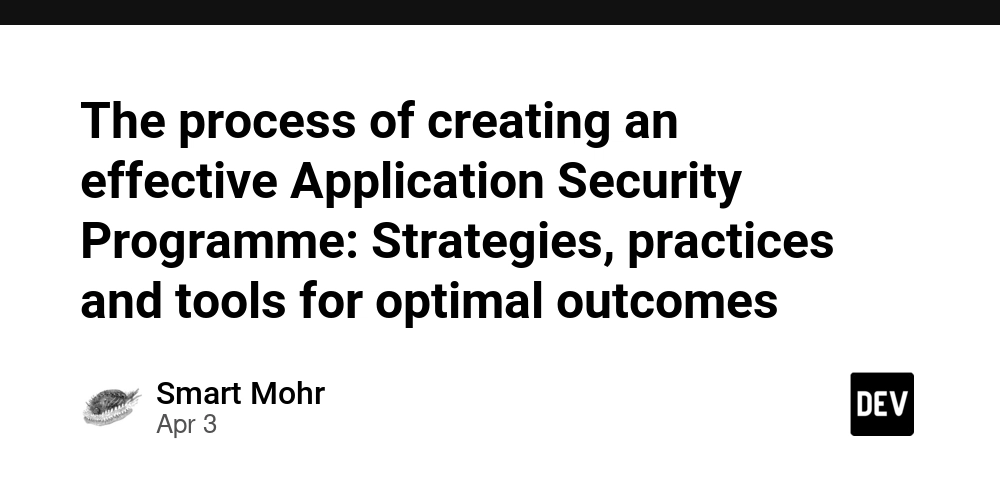The process of creating an effective Application Security Programme: Strategies, practices and tools for optimal outcomes
AppSec is a multi-faceted, robust strategy that goes far beyond the simple vulnerability scan and remediation. The ever-evolving threat landscape, along with the speed of development and the growing complexity of software architectures calls for a holistic, proactive strategy that seamlessly integrates security into every stage of the development lifecycle. This comprehensive guide outlines the essential elements, best practices, and cutting-edge technology that help to create an extremely efficient AppSec programme. It helps organizations enhance their software assets, mitigate risks and foster a security-first culture. The success of an AppSec program relies on a fundamental shift in the way people think. Security should be viewed as a key element of the development process, and not as an added-on feature. This paradigm shift requires the close cooperation between security teams, developers, and operations personnel, removing silos and fostering a shared conviction for the security of applications they create, deploy, and maintain. DevSecOps lets organizations incorporate security into their development workflows. This ensures that security is addressed in all phases, from ideation, design, and implementation, up to regular maintenance. This method of collaboration relies on the development of security standards and guidelines which offer a framework for secure the coding process, threat modeling, and management of vulnerabilities. These guidelines should be based on industry best practices such as the OWASP top 10 list, NIST guidelines, as well as the CWE. They should be mindful of the specific requirements and risk specific to an organization's application and their business context. These policies can be codified and made easily accessible to all interested parties, so that organizations can implement a standard, consistent security strategy across their entire range of applications. In order to implement these policies and to make them applicable for development teams, it is essential to invest in comprehensive security training and education programs. These programs should be designed to provide developers with the information and abilities needed to create secure code, detect vulnerable areas, and apply security best practices during the process of development. The course should cover a wide range of aspects, including secure coding and common attack vectors, in addition to threat modeling and safe architectural design principles. By encouraging a culture of constant learning and equipping developers with the equipment and tools they need to build security into their daily work, companies can establish a strong base for an efficient AppSec program. Alongside training organizations should also set up robust security testing and validation processes to identify and address vulnerabilities before they can be exploited by criminals. This is a multi-layered process that incorporates static as well as dynamic analysis methods along with manual penetration tests and code review. In the early stages of development Static Application Security Testing tools (SAST) can be utilized to identify vulnerabilities such as SQL Injection, Cross-Site scripting (XSS) and buffer overflows. Dynamic Application Security Testing (DAST) tools are, however are able to simulate attacks against running applications, while detecting vulnerabilities that may not be detectable using static analysis on its own. The automated testing tools are very effective in discovering security holes, but they're not a panacea. Manual penetration tests and code reviews performed by highly skilled security professionals are equally important to uncover more complicated, business logic-related weaknesses which automated tools are unable to detect. Combining automated testing and manual validation enables organizations to gain a comprehensive view of the security posture of an application. They can also prioritize remediation actions based on the severity and impact of vulnerabilities. To increase the effectiveness of the effectiveness of an AppSec program, organizations must look into leveraging advanced technologies like artificial intelligence (AI) and machine learning (ML) to enhance their security testing capabilities and vulnerability management. AI-powered tools are able to analyze huge amounts of code and data, identifying patterns as well as irregularities that could indicate security concerns. They can also enhance their detection and preventance of new threats through learning from past vulnerabilities and attack patterns. One particular application that is highly promising for AI within AppSec is using code property graphs (CPGs) to provide greater accuracy and efficiency in vulnerability detection and remediation. CPGs are a comprehensive, visual representation of the application's codebase, capturing not only the syntactic structure of the code but additionally the intricate relationships and dependencies between various

AppSec is a multi-faceted, robust strategy that goes far beyond the simple vulnerability scan and remediation. The ever-evolving threat landscape, along with the speed of development and the growing complexity of software architectures calls for a holistic, proactive strategy that seamlessly integrates security into every stage of the development lifecycle. This comprehensive guide outlines the essential elements, best practices, and cutting-edge technology that help to create an extremely efficient AppSec programme. It helps organizations enhance their software assets, mitigate risks and foster a security-first culture.
The success of an AppSec program relies on a fundamental shift in the way people think. Security should be viewed as a key element of the development process, and not as an added-on feature. This paradigm shift requires the close cooperation between security teams, developers, and operations personnel, removing silos and fostering a shared conviction for the security of applications they create, deploy, and maintain. DevSecOps lets organizations incorporate security into their development workflows. This ensures that security is addressed in all phases, from ideation, design, and implementation, up to regular maintenance.
This method of collaboration relies on the development of security standards and guidelines which offer a framework for secure the coding process, threat modeling, and management of vulnerabilities. These guidelines should be based on industry best practices such as the OWASP top 10 list, NIST guidelines, as well as the CWE. They should be mindful of the specific requirements and risk specific to an organization's application and their business context. These policies can be codified and made easily accessible to all interested parties, so that organizations can implement a standard, consistent security strategy across their entire range of applications.
In order to implement these policies and to make them applicable for development teams, it is essential to invest in comprehensive security training and education programs. These programs should be designed to provide developers with the information and abilities needed to create secure code, detect vulnerable areas, and apply security best practices during the process of development. The course should cover a wide range of aspects, including secure coding and common attack vectors, in addition to threat modeling and safe architectural design principles. By encouraging a culture of constant learning and equipping developers with the equipment and tools they need to build security into their daily work, companies can establish a strong base for an efficient AppSec program.
Alongside training organizations should also set up robust security testing and validation processes to identify and address vulnerabilities before they can be exploited by criminals. This is a multi-layered process that incorporates static as well as dynamic analysis methods along with manual penetration tests and code review. In the early stages of development Static Application Security Testing tools (SAST) can be utilized to identify vulnerabilities such as SQL Injection, Cross-Site scripting (XSS) and buffer overflows. Dynamic Application Security Testing (DAST) tools are, however are able to simulate attacks against running applications, while detecting vulnerabilities that may not be detectable using static analysis on its own.
The automated testing tools are very effective in discovering security holes, but they're not a panacea. Manual penetration tests and code reviews performed by highly skilled security professionals are equally important to uncover more complicated, business logic-related weaknesses which automated tools are unable to detect. Combining automated testing and manual validation enables organizations to gain a comprehensive view of the security posture of an application. They can also prioritize remediation actions based on the severity and impact of vulnerabilities.
To increase the effectiveness of the effectiveness of an AppSec program, organizations must look into leveraging advanced technologies like artificial intelligence (AI) and machine learning (ML) to enhance their security testing capabilities and vulnerability management. AI-powered tools are able to analyze huge amounts of code and data, identifying patterns as well as irregularities that could indicate security concerns. They can also enhance their detection and preventance of new threats through learning from past vulnerabilities and attack patterns.
One particular application that is highly promising for AI within AppSec is using code property graphs (CPGs) to provide greater accuracy and efficiency in vulnerability detection and remediation. CPGs are a comprehensive, visual representation of the application's codebase, capturing not only the syntactic structure of the code but additionally the intricate relationships and dependencies between various components. AI-driven tools that leverage CPGs can perform a deep, context-aware analysis of the security stance of an application, and identify security vulnerabilities that may be missed by traditional static analysis.
Moreover, CPGs can enable automated vulnerability remediation through the use of AI-powered code transformation and repair techniques. AI algorithms are able to provide targeted, contextual fixes by analyzing the semantics and nature of the vulnerabilities they find. This permits them to tackle the root cause of an issue, rather than just treating its symptoms. AI powered SAST This method not only speeds up the remediation process but also minimizes the chance of introducing new vulnerabilities or breaking existing functionality.
Integration of security testing and validating into the continuous integration/continuous deployment (CI/CD), pipeline is another key element of a successful AppSec. Through automated security checks and embedding them into the build and deployment process it is possible for organizations to detect weaknesses early and avoid them being introduced into production environments. This shift-left approach to security enables quicker feedback loops and reduces the amount of time and effort required to find and fix problems.
For companies to get to the required level, they need to invest in the proper tools and infrastructure that can assist their AppSec programs. This is not just the security testing tools but also the platforms and frameworks that allow seamless integration and automation. Containerization technology such as Docker and Kubernetes can play a crucial role in this regard, giving a consistent, repeatable environment for running security tests as well as separating the components that could be vulnerable.
Effective communication and collaboration tools are as crucial as a technical tool for establishing an environment of safety, and enabling teams to work effectively with each other. Jira and GitLab are problem tracking systems that help teams to manage and prioritize security vulnerabilities. Chat and messaging tools like Slack and Microsoft Teams facilitate real-time knowledge sharing and communication between security experts.
The ultimate success of the success of an AppSec program is not just on the technology and tools employed but also on the individuals and processes that help the program. A strong, secure culture requires leadership commitment, clear communication, and an ongoing commitment to improvement. automated security intelligence By fostering a sense of shared responsibility for security, encouraging dialogue and collaboration, as well as providing the appropriate resources and support, organizations can create a culture where security is more than an option to be checked off but is a fundamental part of the development process.
For their AppSec programs to remain effective for the long-term organisations must develop meaningful metrics and key-performance indicators (KPIs). These KPIs can help them monitor their progress as well as identify areas for improvement. The metrics must cover the entire life cycle of an application starting from the number and type of vulnerabilities found in the initial development phase to the time required to address issues, and then the overall security measures. These metrics can be used to demonstrate the value of AppSec investment, to identify trends and patterns and aid organizations in making informed decisions about the areas they should concentrate on their efforts.
To keep up with the ever-changing threat landscape as well as the latest best practices, companies need to engage in continuous learning and education. This may include attending industry conferences, participating in online-based training programs, and collaborating with outside security experts and researchers to keep abreast of the most recent technologies and trends. AI powered application security By cultivating a culture of continuing learning, organizations will make sure that their AppSec program remains adaptable and robust in the face of new threats and challenges.
It is vital to remember that app security is a constant procedure that requires continuous investment and dedication. Organizations must constantly reassess their AppSec plan to ensure it remains relevant and affixed with their goals for business as new technology and development methods emerge. By adopting a strategy that is constantly improving, fostering collaboration and communication, and using the power of cutting-edge technologies such as AI and CPGs. Organizations can develop a robust and flexible AppSec program that does not just protect their software assets but also enables them to develop with confidence in an ever-changing and ad-hoc digital environment.AI powered application security











































































































































































![[The AI Show Episode 142]: ChatGPT’s New Image Generator, Studio Ghibli Craze and Backlash, Gemini 2.5, OpenAI Academy, 4o Updates, Vibe Marketing & xAI Acquires X](https://www.marketingaiinstitute.com/hubfs/ep%20142%20cover.png)




























































































































![[DEALS] The Premium Learn to Code Certification Bundle (97% off) & Other Deals Up To 98% Off – Offers End Soon!](https://www.javacodegeeks.com/wp-content/uploads/2012/12/jcg-logo.jpg)


![From drop-out to software architect with Jason Lengstorf [Podcast #167]](https://cdn.hashnode.com/res/hashnode/image/upload/v1743796461357/f3d19cd7-e6f5-4d7c-8bfc-eb974bc8da68.png?#)








































































































.png?#)

































_Christophe_Coat_Alamy.jpg?#)
 (1).webp?#)





































































































![Apple Considers Delaying Smart Home Hub Until 2026 [Gurman]](https://www.iclarified.com/images/news/96946/96946/96946-640.jpg)
![iPhone 17 Pro Won't Feature Two-Toned Back [Gurman]](https://www.iclarified.com/images/news/96944/96944/96944-640.jpg)
![Tariffs Threaten Apple's $999 iPhone Price Point in the U.S. [Gurman]](https://www.iclarified.com/images/news/96943/96943/96943-640.jpg)




































































































































